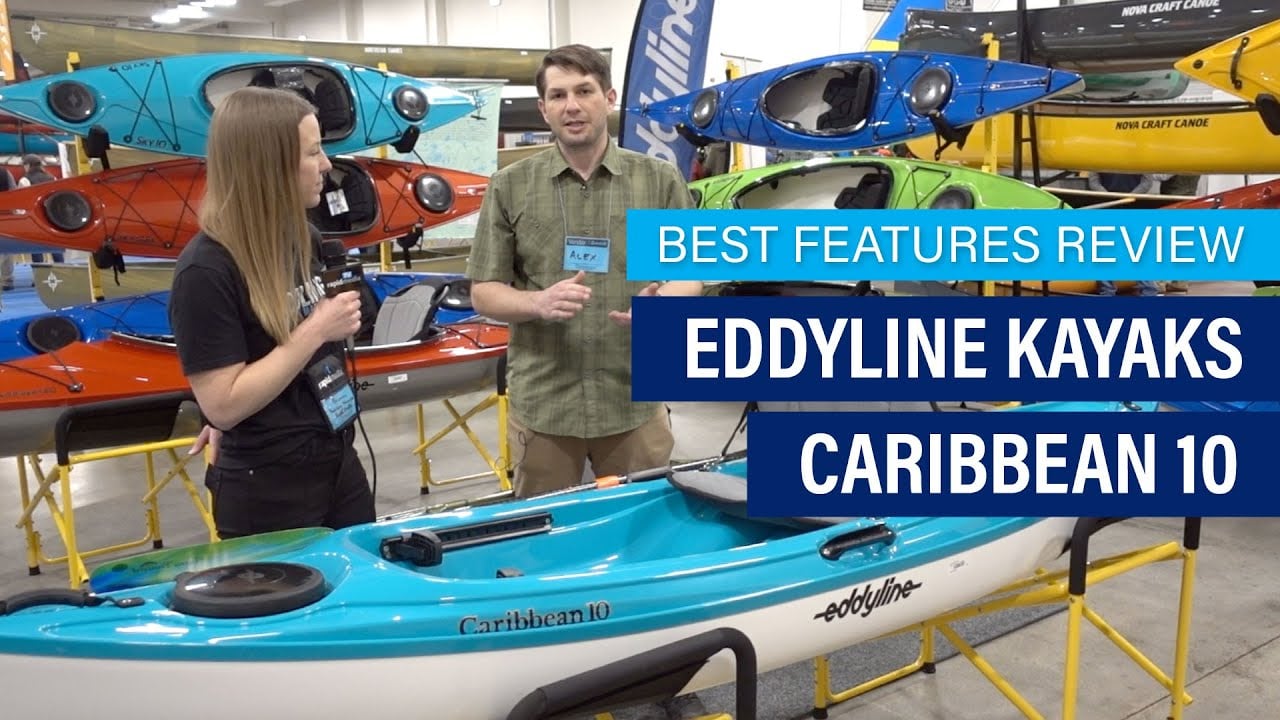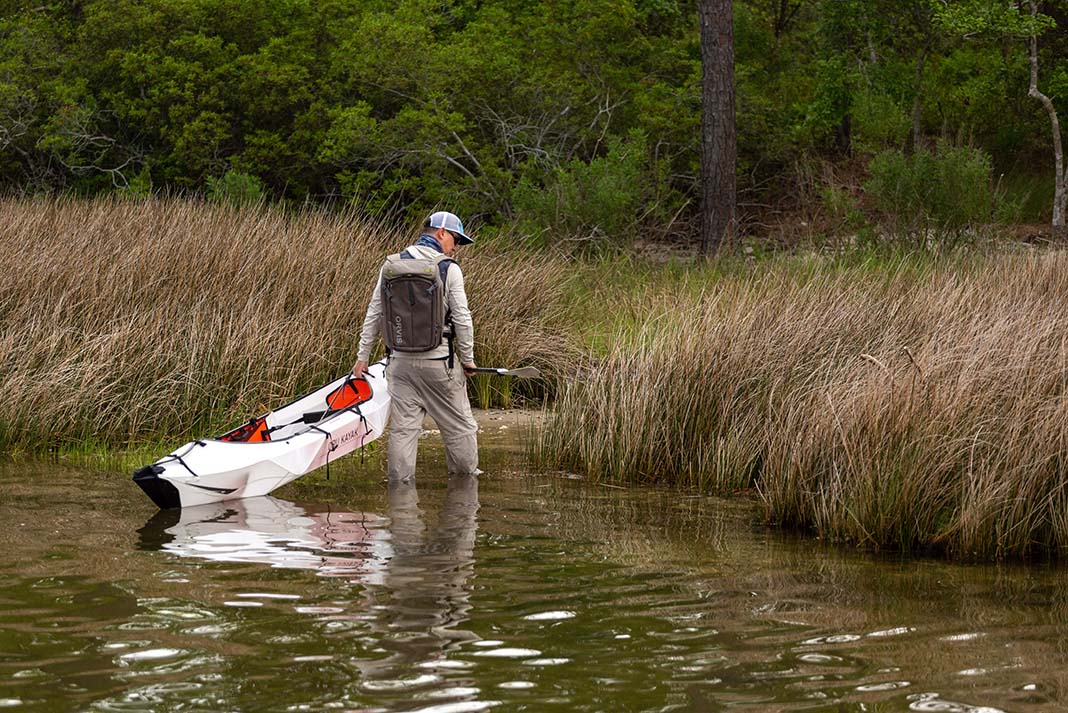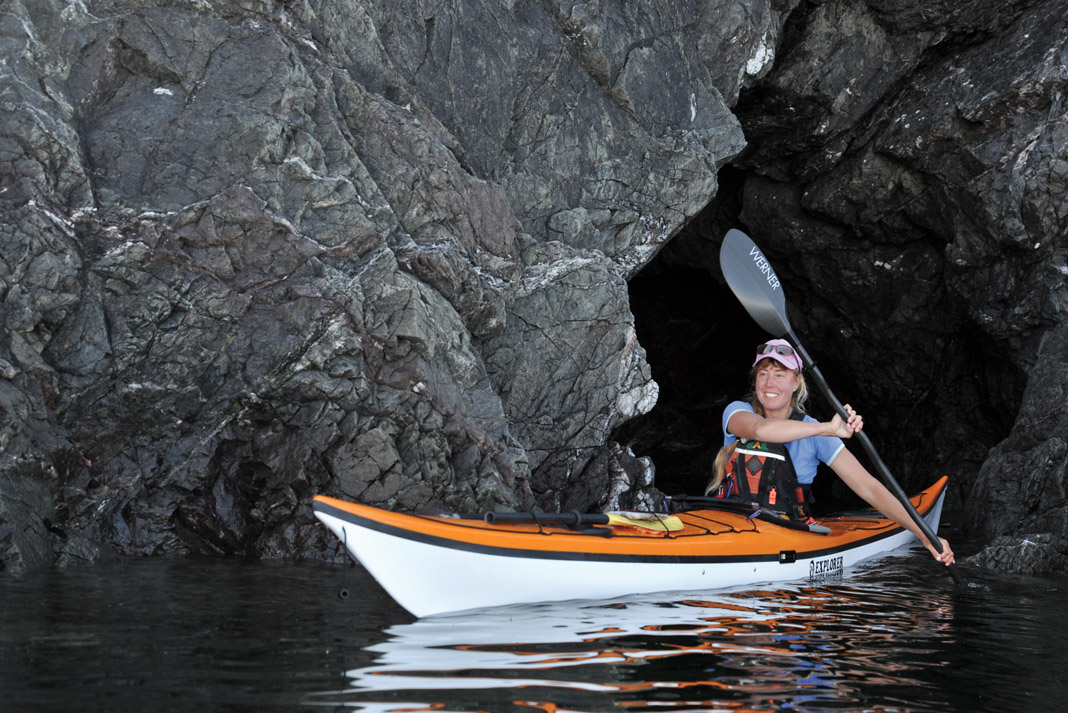The number of kayaks available today is astonishing. The kayak is at least 4,000 years old and was invented as a productive means to secure food and travel. Fast forward to 2025, and millions of people take to the water every year using kayaks for various reasons, including our modern necessity—yearning to spend time outdoors and recreate.
However, the conundrum we find ourselves in is the number of options and just which kayak is the best. It’s a nearly impossible question to answer. Boats have become specialized to different waterways and styles of paddling, but ultimately, the kayak you choose should serve the majority of your needs.
Something I’ll admit as a writer at Paddling Mag is that I could never choose just one form of kayaking, nor just one kayak. I’ll count this burden as fortunate though to aid in the decision-making of others. By paddling everything from lightweight inflatables to elaborate fishing kayaks, whitewater river runners, and seaworthy touring kayaks, I’ve gained a sense of what works and what doesn’t. This isn’t to say there aren’t other kayaks we could have added to the list. Contributors and editors along with myself have field tested dozens of kayaks through the years, and each we’ve spent time paddling has its strengths best suited to waterways and certain types of kayaking. The goal of the picks I’ve chosen here as the best kayak is as much to share with you what to look for in a kayak to fit your needs, as it is to point out the specific kayaks selected here.
- Best budget kayak: Sea Eagle 370
- Best beginner sit-on-top: Eddyline Caribbean 10
- Best inflatable kayak: Nyce Haul
- Best for recreational paddling: Wilderness Systems Pungo 120
- Best folding boat: Oru Inlet
- Best for whitewater: Jackson Flow
- Best for touring: Nigel Dennis Explorer
Best sit-on-top kayak for beginners
Eddyline Caribbean 10
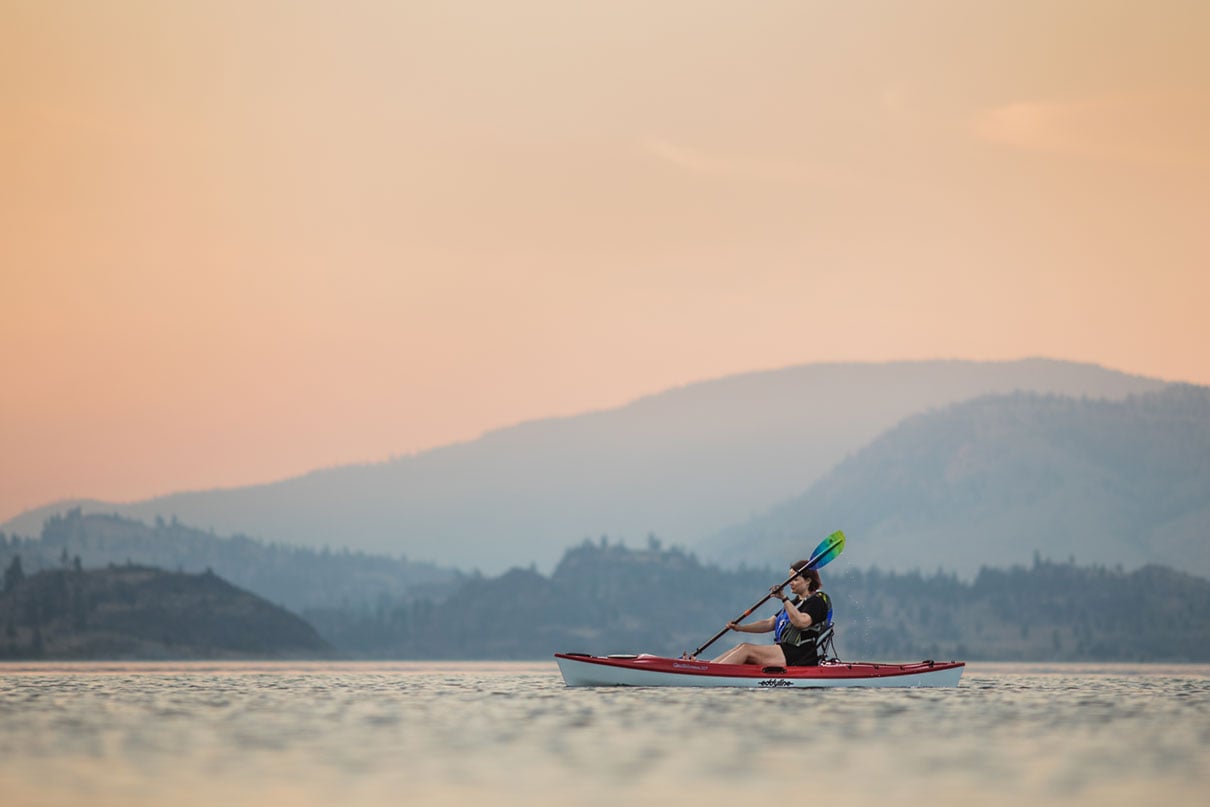
Eddyline Caribbean 10 Specs
Length: 10’ / 3 m
Width: 29” / 74 cm
Weight: 40 lbs / 18 kg
Capacity: 200 lbs / 91 kg
MSRP: $1,299 USD
eddyline.com
Buy from:
Why I love it
Sit-on-top kayaks are some of the finest boats a beginner could consider. They are generally made wider than sit-insides—providing additional stability—and you aren’t enclosed within the cockpit of a kayak. The biggest reason sit-on-tops are some of the best beginner kayaks is if you do happen to fall out or capsize, you can just climb back on. These are all great attributes shared among sit-on-tops, so what makes the Caribbean 10 stand out? Plenty.
The Caribbean 10 is a thermoform plastic kayak—meaning the sheets of molded plastic are fused together to form the deck and hull. Thermoform plastic kayaks can be made light, and at just 40 pounds, the Caribbean is substantially light for a sit-on-top considering a rotomolded plastic kayak of comparable size and outfitting can weigh more than 50 or 60 pounds. This makes it reasonable to lift and carry on your own. Combine this with the fact it is 10 feet long, and you could easily put the boat in the back of a pickup truck or even fit inside an SUV. The 10-foot length also gives the boat a nice balance of attributes. It is just long enough to have some speed, and the V-hull helps it track. Yet, the shorter hull length, and shallow-V also let the kayak spin some, making it easier to turn on a river. At 29 inches wide, it still provides the stability recreational sit-on-tops are known for.
The Caribbean 10 also has a dry hatch at the front to store gear or food, and a well with bungees to stow gear behind you. Top it off with sliding footbraces and a comfortable seat, and you have a beginner sit-on-top at the top of its class.
Reasons to buy
- Lightweight sit-on-top that is less effort to lift and carry
- Fits in the bed of a truck or inside an SUV if you don’t have roof racks.
- 10 feet long and 29 inches wide to provide a length-to-width ratio which is stable but can cover ground on lakes and slow rivers
- More convenient than a sit-inside to get back in should you flip
- Open deck is easy to climb on and off of for folks with mobility issues
Consider another if
- You prefer the enclosed style of a sit-inside
- You plan to cover longer distances or more exposed waters where longer hull touring kayaks would be appropriate
- Your local river includes some whitewater
Bottom line
In a crowded field of sit-on-tops the Caribbean stands out as a superb choice well suited for beginners and any recreational paddler who enjoys casual days of kayaking.
Best sit-inside kayak for recreational paddling
Wilderness Systems Pungo 120
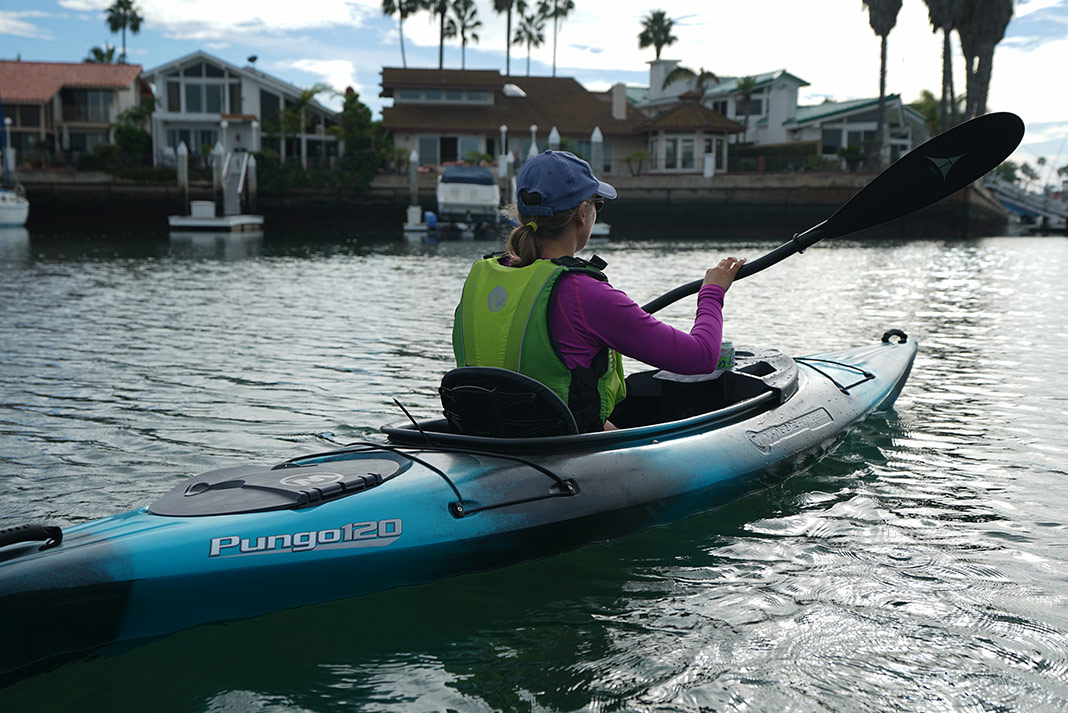
Wilderness Systems Pungo 120 Specs
Length: 12’2” / 3.7 m
Width: 29” / 74 cm
Weight: 49 lbs / 22 kg
Capacity: 325 lbs / 147 kg
MSRP: $1,219 USD
wildernesssystems.confluenceoutdoor.com
Buy from:
WILDERNESS SYSTEMS AMAZON REI SCHEELS
Why I love it
The Pungo 120 is one of the most popular recreational kayaks of the past few decades, and as the saying goes, “If it ain’t broke, don’t fix it.” What makes the Pungo such a well-loved sit-inside kayak for recreational use is the combination of a few details put together to create an enjoyable boat to paddle.
The Pungo 120 is 12 feet long, and while it has enough width to provide stability, it manages to provide some of the elongated profile of a touring kayak to cover ground and have secondary stability. The 12-foot length, shallow V-hull, and keeled stern help the boat track in a straight line. And the boat provides a good sense of stability when it is sitting flat or leaning.
The Pungo features customizable bungee storage, the popular cockpit storage plate, and a stern dry hatch, so you have plenty of space to pack lunch and extra layers on your day trip. The stern dry hatch also means there is a sealed bulkhead between the paddler area and the storage. This helps a sit-inside kayak stay buoyant in the event of a capsize, and bulkheads like this are the mark of a well-designed sit-inside.
Reasons to buy
- 12-foot design provides good tracking and stability for beginner and recreational paddlers
- Multiple storage points
- Wide cockpit area is convenient to climb in and out of
- Comfortable seat
- Dry hatch bulkhead provides buoyancy should you capsize
Consider another if
- You’d prefer a kayak lighter than 50 pounds
- The open concept of a sit-on-top kayak would be more enjoyable or easier for you to enter and exit
- You are looking for a faster kayak or one intended for handling rougher conditions
Bottom line
Whether you are a beginner or recreational paddler who enjoys calmer stretches of water, the Pungo has proven for years it is a sound choice for a sit-inside kayak.
Best budget kayak
Sea Eagle 370
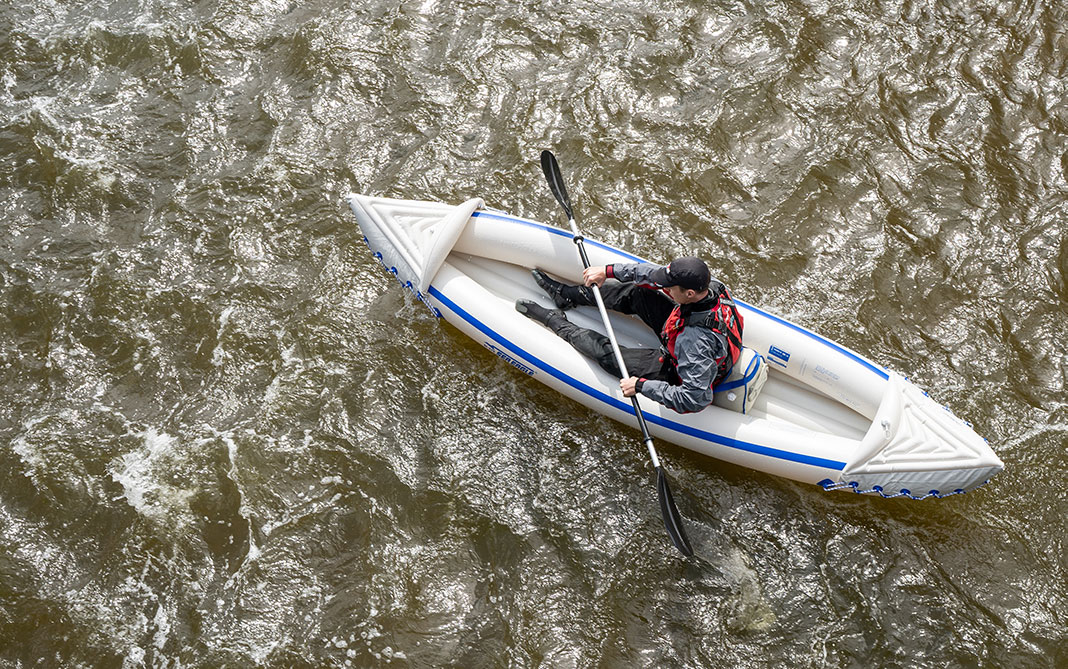
Sea Eagle 370 Specs
Length: 12’6”
Width: 34”
Weight: 32 lbs
Packed size: 31” × 19” × 8”
Capacity: 650 lbs
MSRP: $399 USD (Pro Package)
seaeagle.com
Buy from:
Why I love it
A 12-and-a-half-foot-long inflatable you can take across the lake or down the river, and can be set up as a solo or tandem kayak—could the Sea Eagle 370 get any better? Yes, in fact, thanks to the price tag of just a few hundred dollars.
Sea Eagle is a 50-year-old kayak company based out of New York State. They offer higher-build inflatables, but for the value seeker, it’s hard to match the 370. The subtle components of the 370 are what make it stand out from other low-cost kayaks, including one-way valves for full inflation, a peaked bow and stern, and durable in-class material.
Reasons to buy
- Costs start below $400 USD
- Inflatable rolls up for transport and provides stable feel for beginner paddlers
- Peaked bow and stern cut through some waves and chop
- One-way valve allows for rigid inflation
Consider another if
- The rigidity and performance of a sit-on-top or sit-inside recreational kayak would be preferable or required for use over an inflatable
- You plan to tackle whitewater regularly beyond class II
Bottom line
If you are looking for an all-around budget-friendly kayak the Sea Eagle 370 is a good choice.
Best inflatable kayak
Nyce Haul
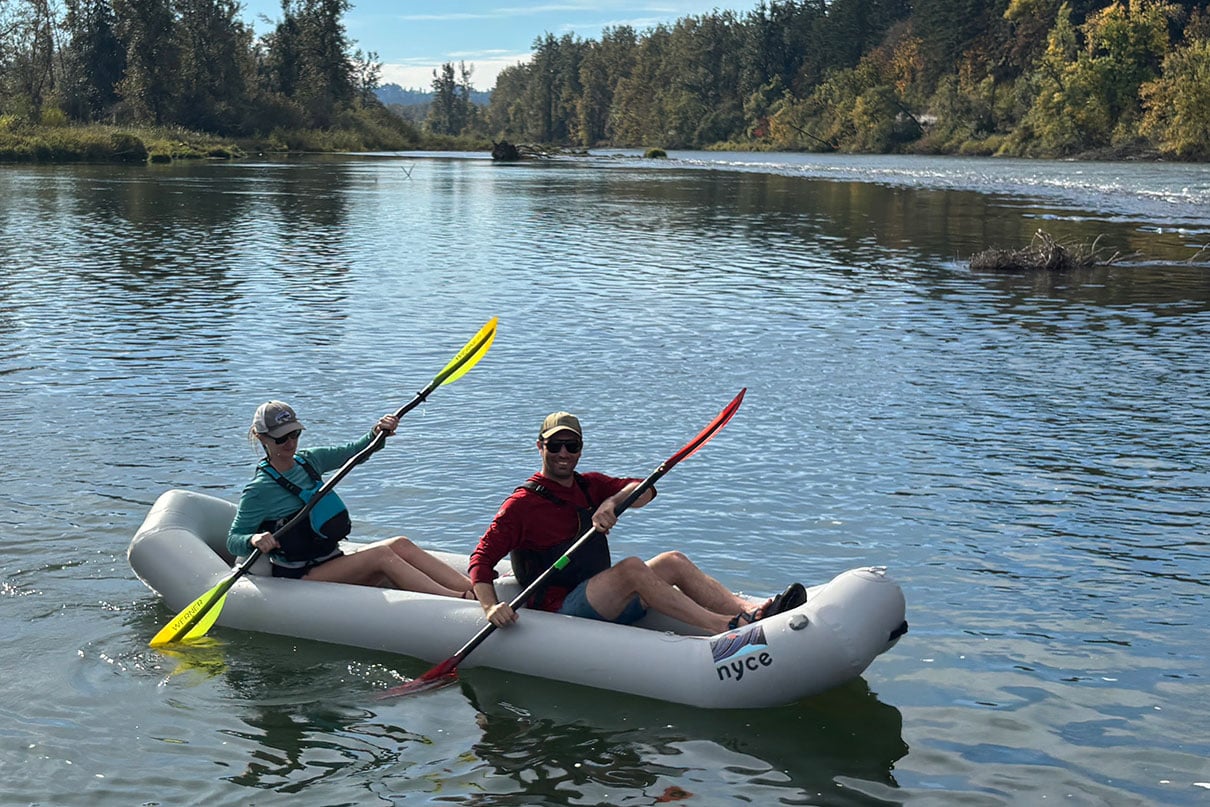
Nyce Haul Specs
Length: 11’2”
Width: 40”
Weight: 44 lbs
Construction: PVC
Capacity: 500 lbs
MSRP: $1,275 USD
nycekayaks.com
Buy from:
Why I love it
Rivers are where inflatable kayaks shine. The dynamic currents of fast moving water mean flips, swims, and a healthy dose of humility are par for the course when you decide to get into whitewater kayaking. Inflatable kayaks however, make the sport more approachable by being wide, stable, buoyant and easier to self-recover into crafts, allowing more people to ride through wave trains and drift through pools to take in the scenery. I’ve paddled a long list of inflatable kayaks over the past 20 years of running rivers and many do the job well, but the Nyce Haul provides an experience that stands out.
The Haul takes on the shape of an elongated raft and feels stable as it smashes through rapids. It can be paddled as a tandem or solo kayak. The outfitting is simple yet thoughtfully considered. My favorite part of the Haul though is the drop-stitched floor. This floor gives the boat a rigidity similar to an inflatable stand-up paddleboard. Not only does the rigid floor help the boat glide across the water, and punch through features, it also opens up the ability to use the Haul as a standing platform to fish as you drift. The floor is also not permanently sewn in, which means it can be easily replaced or repaired, but also, if you should go over some shallow rocks, it can flex to avoid damage in the first place.
Reasons to buy
- Fun and comfortable hitting rapids or floating a lazy river
- Drop-stitched high-pressure floor
- Simple outfitting
- Can set up as a tandem or solo kayak
- Rolls up to store and transport
Consider another if
- Most of your days paddling are on lakes and bays
- You want more elaborate backrests and outfitting
- You prefer a shorter solo boat
Bottom line
When we made our list of the best inflatable tandem kayaks, the Haul took the top spot.
Best foldable kayak
Oru Inlet
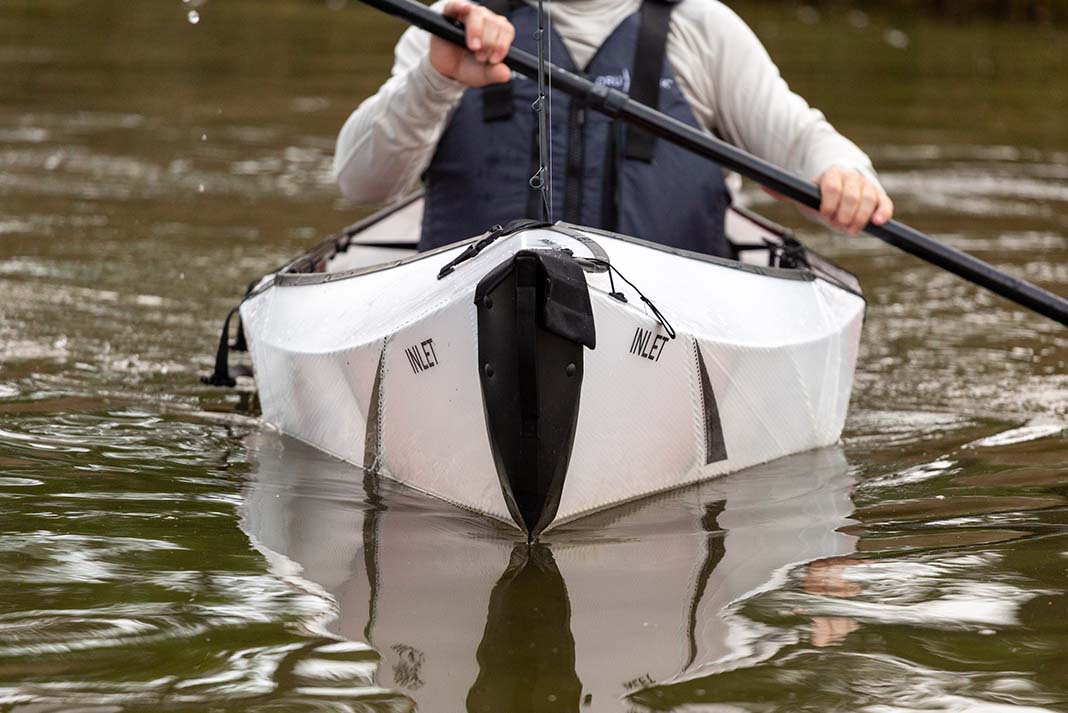
Oru Inlet Specs
Length: 9’8”
Width: 31”
Weight: 20 lbs
Capacity: 275 lbs
MSRP: $899 USD
orukayak.com
Buy from:
Why I love it
Deciding on the foldable kayak to make this list, I could have gone in two directions. One is the boat most embodying the portable needs of intrepid paddlers capable of reaching remote places. The other? The most convenient, making paddling accessible to anyone. I chose the latter, and the Oru Inlet.
The first time I paddled the Inlet was an afternoon on the south side of Staten Island. I walked a few hundred feet with the kayak, in its 20-pound folded form resembling an art portfolio, to a gravel beach on Raritan Bay. Within seven minutes, I had the kayak set up and ready to launch for the first time. On the water it was more stable than I expected. At under 10 feet, the light little boat was zippier than I would have believed. The Inlet shows the brand’s success in the progression of its goal to get people kayaking without the physical dimensions of a boat as an obstacle. If you add in the available backpack, it truly feels reasonable you could take the Inlet by bus, train, ferry or car to any calm or slow stretch of water for an afternoon paddle.
Reasons to buy
- The 20-pound, 10-foot-long kayak packs into itself to the size of luggage
- Intuitive to set up within minutes
- Stable and zippy, considering how light it is
Consider another if
- Your aspirations with a folding kayak involve open water crossings and remote destinations
- A hardshell (plastic or composite) kayak better suits the performance you are after or have the space for
- You plan to tackle whitewater where an inflatable would be a better packable choice
Bottom line
If you’re in search of a unicorn recreational kayak to paddle calm lakes and bays or slow rivers, while being able to store under a bed, the Inlet is the folding kayak you’ve been looking for.
Best for paddling off into the horizon
Nigel Dennis Explorer
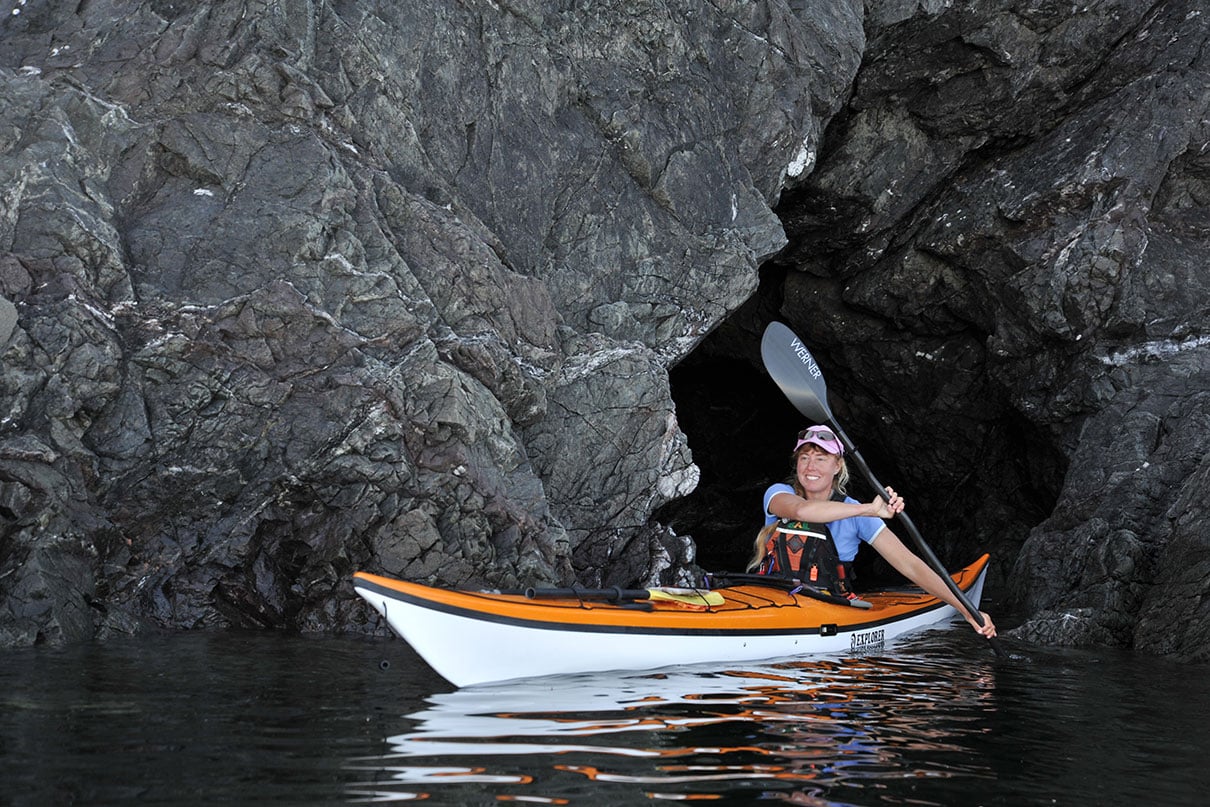
Nigel Dennis Explorer Specs
Length: 17’6”
Width: 21”
Weight: 58 lbs
MSRP: $4,200 USD
Why I love it
When editor-at-large Virginia Marshall reviewed the Nigel Dennis Explorer, she described it as the boat best exemplifying the characteristics of the modern expedition kayak. When Marshall composed her choices for the best touring kayaks, she doubled-down on those words by naming the Explorer her favorite expedition boat out there.
The 17-foot 6-inch-long British-style interpretation of a traditional Greenlandic kayak has a refined look and upswept bow and stern ready to make headway on your most ambitious paddling endeavors. The interior storage has space for trips reaching well beyond a long weekend, but with hatches sized to take a wave with low risk of implosion. Even when loaded to the brim for 10 days, Marshall found the Explorer able to maintain speed and handle confused seas with composure. It’s no wonder the boat is a popular choice for circumnavigations and crossings in some of the world’s burliest corners.
Reasons to buy
- You want an expedition ready kayak you will still enjoy paddling on shorter trips.
- A hull and rocker profile made to maximize touring efficiency in rough waters.
- Custom colors, hatches and layups, including weight-saving carbon/Kevlar.
Consider another if
- Your camping kit includes items like a suitcase stove, barrel and Dutch oven.
- You prefer a highly adjustable seat system to a minimalist cockpit.
Bottom line
The Explorer is a dependable touring kayak that has set a benchmark for the expedition minded.
Best for the river runner
Jackson Flow
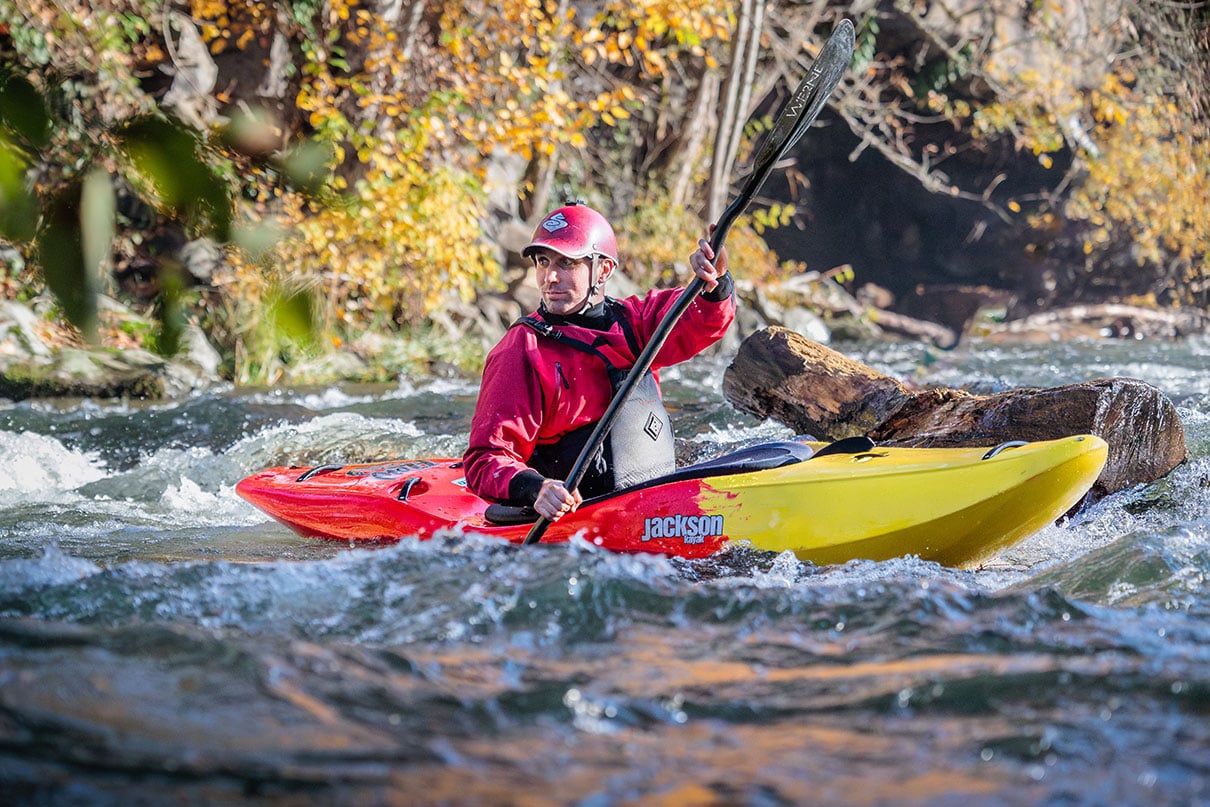
Jackson Flow Specs
Size: S | M | L
Length: 8’1” | 8’5” | 8’9”
Width: 26” | 26.75” | 28”
Volume: 67 | 77 | 86 gal
Weight: 44 | 46.76 | 48 lbs
Capacity: 100–170 | 130–190 | 180–260 lbs
MSRP: $1,649 USD
jacksonkayak.com
Buy from:
Why I love it
What I remember most about the Jackson Flow after my first time sitting in it, was not how I could feel certain differences in the way it handled compared to my other boats, or an adjustment of getting used to its character. The first time I took the Flow on the water, what stood out was the opposite. From the first stroke I took with Flow, it was a kayak where I felt I could do what I wanted when I wanted to. In whitewater, this immediate sense of unison between you and your boat is perhaps the most sought after feeling there could be.
The Flow was Jackson’s attempt to recalibrate the Gnarvana for paddlers on everyday river runs. In my mind, the boat succeeded in this goal and more. If you are a class II-III paddler looking for the trusty steed to up your game, or want a sporty boat for your favorite class V gorge without being buried up to your nose in rocker and volume, the Flow is for you. Set a line, surf, lean and boof, the Flow feels in rhythm to do it all.
Reasons to buy
- The volume around the paddler and easy-to-maneuver hull are confidence-inducing on whitewater.
- Slimmed down compared to the Jackson Gnarvana and other high-volume river runners to feel sporty for advanced whitewater paddlers and user-friendly for newer ones
- The outfitting, especially the Bees Knees thigh braces, can be adjusted on the fly
Consider another if
- Most your time is spent on lakes and slow rivers and you only plan to paddle occasional class I or II whitewater
- You are looking to play the river with a freestyle kayak or half-slice
- Your daily river run is regularly featured in films distributed by energy drinks
Bottom line
The Flow made the top of our list of the best whitewater kayaks overall for good reason.
Buying advice to find the best kayak
As you’ve noticed by now, there are a number of options when choosing a kayak. The top selections made above are as much to recommend these specific kayaks as they are to point out some of the attributes which make them suitable for different types of paddling.
The first thing to figure out when choosing a boat is what type of kayaking you plan to do, and from here you can learn what type of kayak you need. On small lakes, slow moving rivers, and protected bays, a sit-on-top or sit-inside recreational kayak, or even an inflatable, will provide a good all around choice. While if your ambitions include open water crossing or advanced whitewater the kayaks become more specialized for safety and capability.
Once you’ve decided what type of kayak you’d like, you’ll next think about the hull shapes available, whether you’d like a tandem or solo, and then what size kayak is recommended based on the specifications of a few boats you are interested in.
Above all else, the best way to make your choice is to get a hold of a shop or club and see if you can test paddle a kayak or attend a demo event where a group of your prospects are available. Time on the water will tell the truth if a kayak is a right fit for what you’d like to use it for, and also, just as a bike needs to be adjusted for each rider, these testing opportunities usually have someone who can show you how to have the seat, footpegs, and other outfitting components adjusted for you, which makes an incredibly significant difference in how a kayak feels to sit in and paddle.
Best Kayak Brands
- Wilderness Systems
- Perception
- Advanced Elements
- Dagger Kayaks
- Pelican
- Eddyline Kayaks
- Delta Kayaks
- Jackson Kayak
- Pyranha Kayaks
- P&H Kayaks
- AIRE
- Epic Kayaks
- Stellar Kayaks
- Trak Kayaks
- Klepper Kayaks
- Old Town
- Ocean Kayaks
How we tested
The kayaks in this article were chosen through accumulated years of field experience with numerous models and the input of our contributors through our extensive boat reviews.

Why trust us
Our digital editor Joe Potoczak is a self-proclaimed paddler of anything that floats. Over the past 25 years, he has kayaked rivers, lakes and along coasts on four continents. He’ll never forget the boat that started it all—a Mainstream Tropic II from Costco.
Feature photo: Courtesy Eddyline


